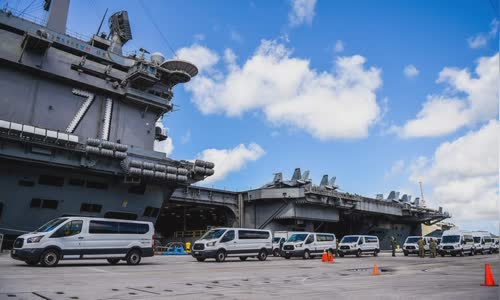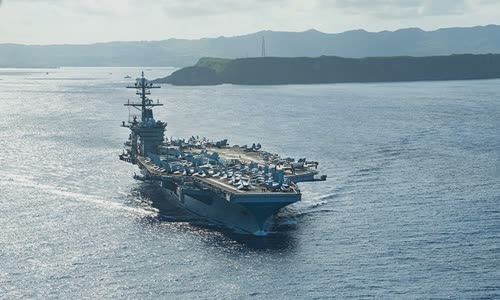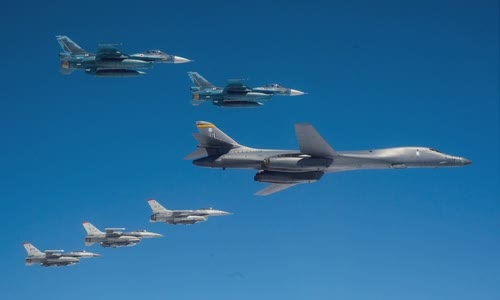The Pentagon has struggled with Covid-19, while maintaining a significant military presence to prevent China from rising in Asia.
The situation did not seem satisfactory for the US Navy in early May, when Chief of Staff Mike Gilday was isolated on his own due to contact with family members infected with nCoV, the aircraft carrier USS Theodore Roosevelt and the destroyer USS

USS Theodore Roosevelt in Guam after the outbreak of Covid-19 Photo: US Navy
USS Ronald Reagan, America's only forward-deployed carrier, also had to deal with a series of nCoV infections while stationed in Japan.
Experts say that the US Navy in particular and the US military in general are facing many challenges when coping with Covid-19, while still maintaining a significant military presence in Asia - Pacific.
US Defense Secretary Mark Esper said earlier this month that Covid-19 "had virtually no significant impact on the readiness" of the US military, but also warned of a "greater impact" in the long run if
It is unclear how many US troops have Covid-19 in the Indo-Pacific region, as the Pentagon requires its operations bases and command posts not to disclose data to ensure security.
According to experts, although the US military can recover very quickly after the pandemic, allies in the region are still skeptical of the US commitment under President Donald Trump and worry that China might find a way to close the gap.
"There is a certain concern in Japan about the readiness of the US army due to the pandemic," Collin Koh, a scholar at Singapore's S. Rajarnatnam School of International Studies, said.
According to Koh, as a regional and influential regional power in the Indo-Pacific, Japan will have to take action soon to shoulder the role when the US military has problems with its readiness to fight.

The US completed a carrier cluster investigation Photo: US Navy
While Washington and Beijing are fighting about the origin of the nCoV and how to respond to pandemics, Chinese media have been actively propagating the theory that the US military is seeking to hide its weakened position because of its epidemic.
"The recent issue in Chinese state media is to send the message that the US military is in trouble with the pandemic, they were abandoned by politicians in Washington due to the administration of President Donald Trump.
Observers, meanwhile, were skeptical of the Chinese military's claim that they had not recorded any cases of nCoV among the two million active troops.
"It's hard to believe that their combat readiness is not affected by nCoV. The Chinese military may be trying to hide its challenges with combat capabilities through showing a strong outside image,"
In addition to promoting propaganda in the media, China also continues to increase aggression activities in the East China Sea, East Sea and the area near the island of Taiwan.
Chinese coast guard vessels in early May chased Japanese fishing boats near the disputed Senkaku / Diaoyu Islands and have been present for the first time in three consecutive days since 2016.
Over the past month, the Chinese navy has conducted live-fire exercises to increase its "combat capability", while the Geological Survey 8 was deployed to the southern part of the South China Sea, near the site.

B-1B bomber exercises with US F-16 and F-2 fighters on April 22 Photo: USAF
Reed Werner, Deputy Assistant Secretary of Defense for Southeast Asia, said Chinese fighters had harassed US reconnaissance at least nine times in the South China Sea since the end of March.
Werner also accused China of "harassing" the destroyer USS Mustin when it operated near the Chinese aircraft carrier combatant group that passed through the South China Sea in April.
Although allies are concerned about the readiness of the US military, there are signs that the country is still capable of maintaining a stable military presence in the region.
The US Navy has carried out freedom of navigation patrols near artificial islands occupied by China and illegally renovated, and deployed amphibious assault ships USS America carrying stealth fighter F-35B.
The US Navy Pacific Fleet earlier this month made a surprise move by announcing the entire fleet of forward submarines were simultaneously carrying out "emergency response operations" in the waters of the Western Pacific, in
"These public moves are clearly in response to China's propaganda campaign, demonstrating that US military power in the Western Pacific region has not diminished," said Olli Suorsa, a scholar at the National Research School.
"While allies and partners may be very worried about the US presence in the region, so far there is no sign that the United States is cutting its commitment. On the contrary, the US military seems to be increasingly concerned.



 Nerwin De Vera
Nerwin De Vera







